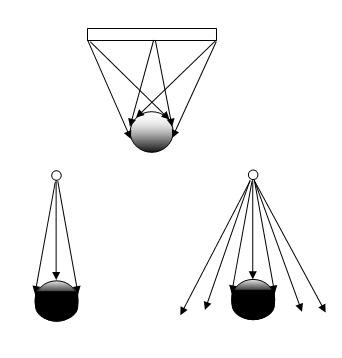Often, I'll hear of a photographer who wants to "diffuse" the light in order to "soften" it. I want to demonstrate once and for all that diffusion by itself does not soften light.
Soft light as we know is light that has soft-edged or even undetectable shadows. Soft light comes from a light source that has a large apparent size compared to the subject. Hard light is light that has clearly defined shadows. Hard light is produced by a light source with a smaller apparent size than the subject.
Diffusing light means to spread it out. For example, the popular Sto-Fen Omnibounce diffuser is attached to the flash head, and it has tiny prism-like shapes on its surface in order to spread out the light.
THE EXPERIMENT
To prove that diffusion does not soften light, I did the following experiment. I placed a flash on a tripod aimed directly at the subject (me), outdoors at night (to have fairly constant ambient light). I took a test shot at sync speed with the flash zoomed to 50mm (the same as the focal length). I took a comparison shot with the flash at its widest zoom setting (24mm), with the built-in diffusion panel PLUS the Nikon-supplied diffusion cap (similar to the Sto-fen Omnibounce). Both flashes were on TTL to maintain flash exposure. Here are the shots (feel free to zoom in):
SHOT A:
SHOT B:
I purposely did not identify which one was shot with a diffuser. Not surprisingly, you can't tell the difference because they look pretty much the same in terms of the quality (softness vs. hardness) of the light. BTW, the first shot is the one with the diffuser.
THE EXPLANATION
The quality of light is determined only by the apparent size of the light source. Given that the flash head and the flash head with diffuser have an identical apparent size, they have identical quality. Check out these diagrams:
The top diagram shows a large light source which illuminates the shaded portion of the subject. Because only certain parts of the light source (i.e., not all of it) illuminate the subject, the illumination of the shadow appears as a gradient, which we perceive as softer light.
The bottom left diagram shows a small light source without diffusion. The bottom right diagram shows the same small light source with diffusion. From the diagram we can see that diffusing the light doesn't cause any additional light to fall on the shaded part of the subject.
IS A DIFFUSER TOTALLY USELESS?
I wouldn't say it's totally useless. It's pretty handy for putting ketchup. Seriously, a diffuser can be used at least three ways. First, a diffuser can cause softening of shadows if the diffused light has a chance to bounce off from nearby reflective surfaces which in turn illuminate the subject.
Second, diffusion is also useful when the diffusing surface is larger than the original light source. For example, a shoot-through umbrella is a diffusing surface. It works because the umbrella is much larger than the flash, and therefore the umbrella produces a softer light.
A third legitimate use for a diffuser is to spread the light. In the umbrella example, if the flash head were equipped with a diffuser, the light may be spread out more evenly across the umbrella than if the flash were zoomed. (I wouldn't do that though... it would waste the flash's power, and hotshoe flashes only have so much.)
AN EFFECTIVE WAY TO SOFTEN LIGHT
If you want to soften light effectively, try bouncing the flash (without a diffuser, which will just waste output). If there is no bouncing surface available, try a handheld umbrella instead, either with a purpose-built handheld bracket, or a regular umbrella bracket.



Nice article Mic... thanks for sharing
ReplyDeleteThanks Santosh.
ReplyDelete